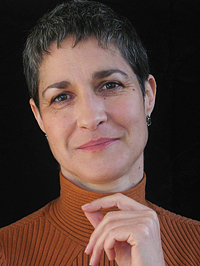In this week’s eSkeptic:
Lecture Sunday: Margaret Wertheim
Physics on the Fringe: Smoke Rings, Circlons,
and Alternative Theories of Everything
Sunday, December 11, 2011 at 2 pm
Baxter Lecture Hall
FOR THE PAST 15 YEARS acclaimed science writer Margaret Wertheim has been collecting the works of “outsider physicists,” many without formal training and all convinced they have found true alternative theories of the universe. Jim Carter, the Einstein of outsiders, has developed his own complete theory of matter and energy and gravity that he demonstrates by experiments in his backyard—with garbage cans and a disco fog machine, he makes smoke rings to test his ideas about atoms. Captivated by the imaginative power of his theories and his resolutely DIY attitude, Wertheim has been following Carter’s progress for the past decade. Through a profoundly human profile of Carter, Wertheim’s exploration of the bizarre world of fringe physics challenges our conception of what science is, how it works, and who it is for.
Tickets are first come, first served at the door. Seating is limited. $8 for Skeptics Society members and the JPL/Caltech community, $10 for nonmembers. Your admission fee is a donation that pays for our lecture expenses.

NEW ON MICHAELSHERMER.COM
Sacred Salubriousness
In the December Skeptic column for Scientific American, Michael Shermer looks at new research on the link between religion, behaviour, goal achievement and self-control.
NEW ON SKEPTICBLOG.ORG
Paleolithic Politics
Research in cognitive psychology shows, for example, that once we commit to a belief we employ the confirmation bias, in which we look for and find confirming evidence in support of it and ignore or rationalize away any disconfirming evidence. In this Skepticblog, in light of the group-psychology of our ancestral past, Michael Shermer looks at how the confirmation bias affects our still-tribal political process.

Unbottling some Jinn
If you think Genies are funny like in Aladdin, or sexy like in I Dream of Jeannie get ready to have your assumptions challenged. In the Middle East, Jinn aren’t whimsical characters of fantasy. They are considered to be frightening, real entities that haunt desolate places and can perform terrible magic. In this episode of MonsterTalk we interview author Robert Lebling about his book Legends of the Fire Spirits: Jinn and Genies from Arabia to Zanzibar. If you miss this episode you’ll wish you hadn’t!
Get the Podcast App
for your Android phone.
(iPhone App coming soon)
About this week’s eSkeptic
In this week’s eSkeptic, we present Karen Stollznow’s “Bad Language” column from Skeptic magazine volume 16, number 4 (2011) in which she looks at some of the pseudoscientific claims about the healing powers of sounds. Though most sound healing claims are just a lot of hot air, could there be some legitimate applications of sound technology being used to heal?
Healing and Harming Sounds
by Karen Stollznow
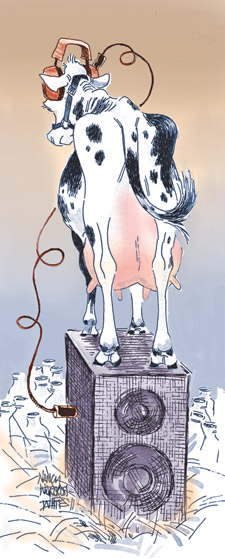
Illustration by Nancy White
Pavarotti singing Nessun Dorma from Puccini’s Turandot can bring people to tears, but can the tenor’s voice heal too? Can sounds both cure and kill? Let’s investigate some claims about healing and harming sounds.
Many people seem to think there’s something magical about human speech; for example, the belief that uttering spells and prayers can bring about an effect in the external world. Some practitioners even claim to be able to cure disease using the human voice. As usual, there are many names for the claims: Bioacoustics, Sound Therapy, Sound Work and Sound Medicine. All of these methods purport to harness the alleged healing power of our own voices.
One proponent, Paul Newham, believes that good health requires not only a sensible diet and exercise, but also singing. His book The Singing Cure teaches “Voice Movement Therapy,” a series of exercises based on “vocal healing traditions” from indigenous cultures.1 Newham claims the voice is a powerful healing instrument that can be used to tame anger, grief, shame and other negative emotions.
One “certified therapist” in Voice Healing conducts sessions of singing to reduce stress, ease pain and create a “cellular level of healing”:
This powerful healing technique which dates back to ancient civilizations and new scientific researches, will enable you to use the power of your voice vibration to improve your health and life. This course is for everybody; the human voice is a very powerful tool. it was not only created to speaking or singing, but also to heal and help each one of us (having a beautiful voice is not relevant) to achieve a state of greater self awareness. Once we get to know our voices with the help of intensive training we will be able to cure ourselves from many disturbing diseases and multiple pains caused by stress, such as insomnia, migraine, abdominal pain, heart problems, sinusitis, cold flu, and more…2
The Discovery Channel television series Mythbusters proved that with the right frequency and volume, and when sustained, it is possible to shatter glass with the human voice.3 However, no note is going to cure the common cold. Like mantras and meditation, singing only has subjective benefits for the individual.
Another therapist uses the voice in conjunction with music, drums, quartz crystal bowls and tuning forks, to return our voices to their “healthy state of resonance”:
We arrive on this planet with every thing that we need to heal ourselves, and when we came; our voices were rich with all the necessary frequencies to maintain us in a healthy state of resonance. Due to the conditioning of childhood and the suppression of our true thoughts and feelings and the accompanying sounds that go with them, by the time we arrive at adulthood our speaking voice no longer contains the same frequencies it did as a child. Our voice will always reflect our current mental and emotional states of being. When a person feels alive, healthy, happy and abundant, their voice sounds much different than if they are depressed, unhappy, angry or afraid. You may notice a difference in your own voice when speaking your truth compared to when you are not, it feels different in your body as well, and from an energetic standpoint the cells of your body are not getting the frequencies they need to stay healthy.4
Consistent with the beliefs of other holistic therapies such as naturopathy, this therapist claims that we all have a natural healthy state to which we can return using the body’s innate ability to heal itself.
To return to this inherent state of health, Alfred A. Tomatis experimented with the most seminal of sounds—a mother’s voice. To his patients, Tomatis played recordings of their mother’s voices to treat a variety of disorders, including dyslexia, autism and depression. He also used Gregorian chants and music by composer Wolfgang Amadeus Mozart. To this day, proponents of the Tomatis Method claim his listening techniques treat learning difficulties, and assist in learning second languages, developing better communication skills and improving creativity.5
By now, the idea of using Mozart music might be sounding familiar. Don Campbell took Tomatis’ research further with his book The Mozart Effect: Tapping the Power of Music to Heal the Body, Strengthen the Mind, and Unlock the Creative Spirit. Campbell believes that listening to Mozart music boosts intelligence, and in The Mozart Effect for Children he claims that exposing children to classical music increases brain development.
Campbell’s theory was popularized before it could be (dis)proven. The mere claim led then Governor of Georgia, Zell Miller, to propose issuing the parents of newborn children with a CD of classical music.6 In an effort to produce more milk, a dairy farmer in Spain plays Mozart during milking time, in what is affectionately known as the Moozart Effect.7
However, research does not support the claim that listening to Mozart can enhance spatial performance.8 Furthermore, there is no evidence to support Campbell’s additional claims that his therapy treats a range of conditions including autism, dyslexia and Attention- Deficit Hyperactivity Disorder (ADHD).9 Much like the “we only use 10% of our brains” myth, the belief that “listening to Mozart makes you smarter” has outlived its debunking.
Again, any benefits of listening to classical music are based in perception, like taste in music. One person’s Mozart is another person’s Metallica. Similarly, there is no music that will literally “expand your mind” like the claims of Squareeater that their psychedelic music “stimulates the brain to lead users to the furtherest edges of the conscious mind.”10
Music isn’t always used to soothe the savage beast; sometimes it’s used as a torture tactic. There was a curious soundtrack to the 1993 Waco siege of David Koresh and his disciples. When negotiations failed, the Federal Bureau of Investigation surrounded the Branch Davidian ranch and blasted high-decibel music into the compound to subdue the occupants. The bizarre playlist included Tibetan chants, Christmas carols, bugle calls and Nancy Sinatra’s These Boots Are Made for Walkin’. Like Charles Manson, Koresh fancied himself a rock star, and retaliated by playing tapes of his own compositions, until the electricity was cut off….
U.S. soldiers unleashed this rock ‘n’ roll warfare during the 1989 invasion of Panama. A cacophony of Styx, Judas Priest, Black Sabbath, and a version of God Bless the U.S.A. was blasted into the papal nunciature—Manuel Noriega’s hiding place—until the Vatican put an end to the concert. Closer to home, classical music is pumped into the PA systems of some shopping malls in an attempt to lower crime and deter teenagers from loitering (because Beethoven isn’t cool).
Sometimes earplugs aren’t enough. Sonic weapons are coming out of science fiction and into use for defense and law enforcement. Instruments such as Long Range Acoustic Devices (LRAD) are used as hailing devices and in crowd control efforts. An LRAD was even used to ward off a group of pirates off the coast of Somalia. High-power sound waves can be used to incapacitate a victim, and can cause disorientation, discomfort and nausea.
The very technology used to harm may be used to heal. Researchers at the California Institute of Technology have created “sound bullets” that could eventually be used to obliterate kidney stones or destroy cancerous cells without damage to surrounding tissue.11 The device is based on the old toy Newton’s Cradle, and creates concentrated sound waves from ball bearings.
In experimental research, sound waves are being used to treat prostate cancer. In a study conducted at the University College Hospital and Princess Grace Hospital in London, High Intensity Focused Ultrasound (HIFU) is used to kill cancerous cells. The results are promising; the cancer was treated successfully, with fewer side effects than chemotherapy.12
As we can see, there are some legitimate applications for sound technology, but there are many pseudoscientific theories about speech and sound. The claims that singing can cure disease and listening to music can make you smarter are just a load of hot air.![]()
References
- Paul Newham. 1993. The Singing Cure: Introduction to Voice Movement Therapy. Rider & Co.
- Manifesting Mind Power. Voice Healing. www.manifestingmindpower.com/voice%20healing.htm Accessed 04/20/2011.
- Karen Schrock. 2007. “Fact or Fiction? An Opera Singer’s Piercing Voice Can Shatter Glass.” Scientific American.
- The Healing Voice. www.soundtransformations.com/sacredvoice.htm Accessed 05/12/2011.
- Tomatis Method. www.tomatis.com Accessed 05/11/2011.
- Kevin Sack. 1998. “Georgia’s Governor Seeks Musical Start for Babies.” The New York Times. www.nytimes.com/1998/01/15/us/georgia-s-governor-seeks-musical-start-for-babies.html Accessed 05/11/2011.
- Rebecca Lee. 2007. The Moozart Effect. abcnews.go.com/Technology/story?id=3213324&page=1#.Tt6l5WCt_8g Accessed 05/11/2011.
- Pippa McKelvie, Jason Low. 2010. “Listening to Mozart does not improve children’s spatial ability: Final curtains for the Mozart effect.” Developmental Psychology. Vol. 20, No. 2, 241–258.
- Campbell, Don. 1997. The Mozart Effect: Tapping the Power of Music to Heal the Body, Strengthen the Mind, and Unlock the Creative Spirit. Quill Publishing.
- Squareeater. www.squareeater.com/ Accessed 05/17/2011.
- “Sound bullets” could blast cancer. ABC Science. April 2010. www.abc.net.au/science/articles/2010/04/06/2865165.htm Accessed 04/20/2011.
- Ahmed et al. 2009. “High-Intensity-Focused Ultrasound in the Treatment of Primary Prostate Cancer: The First UK series.” 1 July. British Journal of Cancer.
Suggested reading on sound perception, faith healing, and prayer…
-
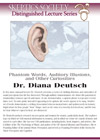 Phantom Words & Auditory Illusions
Phantom Words & Auditory Illusions
by Dr. Diana Deutsch
-
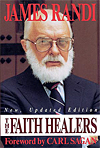 The Faith Healers
The Faith Healers
by James Randi
-
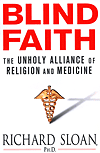 Blind Faith: The Unholy Alliance
Blind Faith: The Unholy Alliance
of Religion & Medicine
by Richard Sloan -
Is there a scientific connection between prayer and healing? A majority of Americans believe there is, but by taking a hard look at the scientific evidence, Columbia University Professor of Behavioral Medicine, Richard Sloan, believes there is no proven curative power to prayer and that the use of it as a medical treatment undermines effective patient care. Sloan exposes the questionable research practices and unfounded claims made by scientists who manipulate scientific data and research results to support their claim of effective mystical intervention in healing. READ more and order the hardback book.


